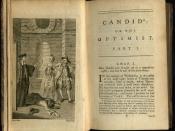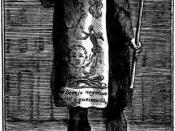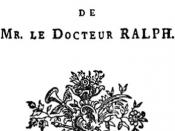INTRODUCTION
This coming of age story illustrates how the central character, Candide, tries to find ways to build up a new outlook of the world he lives in, while he makes a great effort to overcome his many misfortunes. His injudicious guide, Pangloss, has a great sway over his thoughts all through the story. This results in an internal inconsistency in Candide because he must choose whether he should free himself from Pangloss's illogical optimism or believe him and stay with him.
IRRATIONAL OPTIMISM
Pangloss and his student Candide believe that "It is demonstrable that things cannot be otherwise than as they are; for as all things have been created for some end, they must necessarily be created for the best end" (Candide 2001) This idea is a cut down version of the philosophies of various Enlightenment thinkers especially Gottfried Wilhelm von Leibniz. To these thinkers, the reality of any malevolence in the world would have to be an indication that God is either not completely superior or not omnipotent, and the idea of a flawed God is senseless.
The optimists, Pangloss and Candide, undergo and observe a broad array of dismays floggings, rapes, thefts, undeserved capital punishment, sickness, an earthquake, disloyalty, and devastating ennui. Pangloss tries to find explanations for the dreadful things in the world, but his opinions are simply ridiculous, as, for example, when he asserts that syphilis needed to be spread from the Americas to Europe so that Europeans could benefit from New World delicacies. More clever and experienced characters, such as the old woman, Martin, and Cacambo, have all reached negative conclusions about humankind and the world.
THE DOUBLE STANDARDS OF CREED
Voltaire mocks organized religion by means of a sequence of dishonest, two-faced spiritual leaders who come into view...


